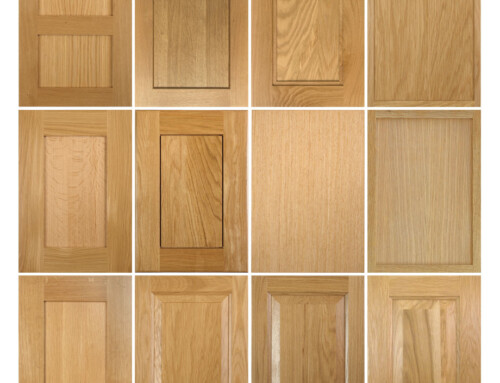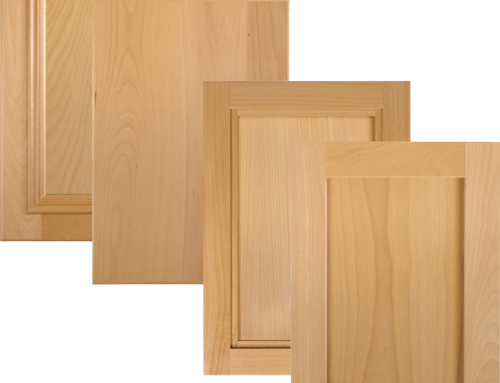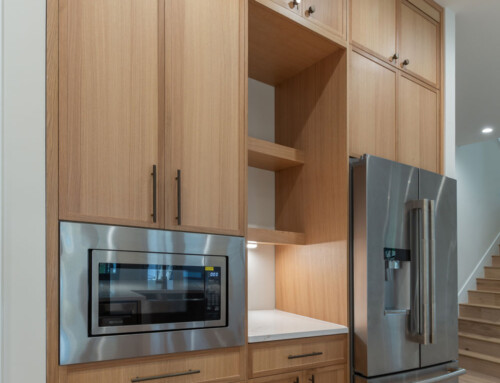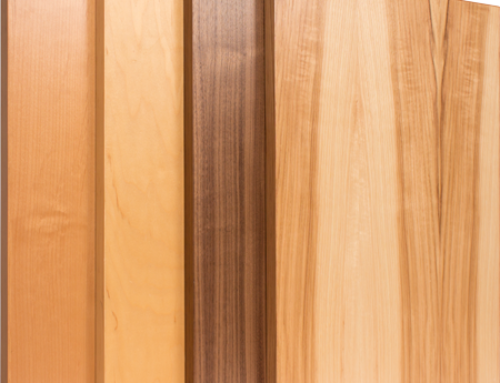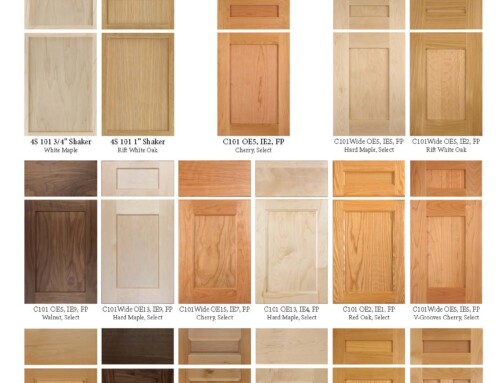There are dozens of types of wood stains, glazes, paints and sealers and there are nearly as many different ways for applying them, making the topic confusing and overwhelming for many homeowners in the market for new cabinets. To help homeowners understand the finishing vocabulary of cabinetmakers, we put together this Cabinet Finish and Stain Glossary. If we missed any finishing terminology or if any corrections to our information are needed, cabinetmakers, please let us know and we’ll be sure to update our list.
Blotching is uneven stain color on wood cause by inconsistent porosity/density of the material and the inconsistent stain color absorption into the material. Soft woods like pine are typically the most prone to blotchiness along with alder, poplar, fir and spruce. However hard woods like maple with mostly hard, smooth surface area that resists stain absorption, and some unpredictable areas of porous, surface end grain that readily absorb stain, are also prone to blotchiness.
Gel Stain is a thickened stain used on porous wood to give a more even, less blotchy look. This thick gel sits on top of the wood surface, and does not settle into the deep pores of the wood. This thick material is less likely to run or splatter. Gel stains are often used on non-porous woods that contain areas of porous end grain, which create unpredictable areas of dark and light stain absorption. Gel stains tend to pool in corners, v-grooves, and detailed areas, making those areas darker.
Lacquer is one of the fastest drying finish types and is typically sprayed on whereas and shellaq and varnish are typically brushed on. Lacquer is similar to shellaq in that its’ name comes from the female lac insect (Laccifer Lacca), whose resin secretions during mating season are used to make lacquer and shellac. Lacquer is typically shellac mixed with another resin such as a polymer or plasticizer that allows it to bind to previous coats of lacquer, along with a mixture of one or more solvents. The result is an extremely hard but still flexible finish that is more durable than shellaq or varnish. Lacquers harden through evaporation of their liquid solvents into the air which can happen in as little as 5-10 minutes.
Shellaq is made using resin secretions from the female lac insect mixed with solvent (commonly alcohol) and is a fast-drying clear top coat that is easily damaged by exposure to moisture, heat and abrasion and is less durable than lacquer or varnish so it is often used on non-wood surfaces that will not receive much abuse. Shellaq is typically applied with a brush or cloth and produces a glossy surface.
Varnish is made from oil cooked with resin as the binder, and dries more slowly than shellaq and lacquer. Varnish is typically glossy but can also be made with a satin sheen. Varnish dries to a very hard, durable surface through the oxidation process, and can take up to a month to fully harden. Once it is fully oxidized, varnish resists damage by water, abrasion, heat and solvents which is why marine-grade varnish (made with higher oil to resin ratio) can be used outdoors. Varnish is thicker, more flammable, and has a much longer drying time than lacquer.
Varnish is typically colorless unless the product is a combined stain-varnish, and is commonly used as a top coat on pieces that have already been finished and need to be refreshed or products that need a protective top coat. Varnish differs from other finishes in that clean up and thinning must be done with mineral spirits verses cleanup and thinning with other solvents. Varnish may yellow over time.
Polyurethane is a versatile type of plastic used in a wide variety of applications from insulation to toys. Polyurethane is used in the form of a liquid in wood finishes, until it dries to create a flexible and durable top coat. Polyurethane finish is available in both water-based options (somewhat less durable but also less odor and is colorless) and oil-based (more durable and heat resistant than water based but cleanup is more difficult, it takes longer to dry and can add a yellow/amber hue to the wood). Polyurethane based finish comes in varieties from satin to glossy.
Spray stain is any stain that can be sprayed on, typically with a spray gun and is typically thinner consistency than stains that are brushed on. Read the thread on woodweb for advice on spray stains.
Wiping stain is any stain that needs to be wiped off after application and can be applied by spray, brush, cloth or any other means. When wiping stains are not properly wiped off after application, adhesion of subsequent finish layers is affected and the results can be unpredictable and ugly! Read Bernie Bottens’ blog article on wiping stains for more information.
Wood conditioner is often used to pretreat porous wood or very non-porous wood that has unpredictable sections of porous end grain. Some woodworkers prefer to use gel stains rather than wood conditioner due to the overnight drying time typically needed prior to sanding and staining when starting with wood conditioner, the extra sanding steps before applying the stain on top of conditioner and the extra layers of stain needed to achieve darker colors on top of conditioner because of lower stain absorption rate.
Clear stain protects the wood from water and food and can block UV rays from the sun while still leaving the natural wood color and grain intact however the UV blocking properties of clear stains are not typically as good as semi-transparent.
Semi solid stain has less pigment than solid stain color so you can still see the woodgrain through the color though the color does completely transform the color of the wood underneath.
Solid stain completely conceals the wood grain pattern but you can see any wood texture that hasn’t been sanded down.
Semitransparent stain has some pigment which helps to block UV rays, but not enough to color completely block the original woodgrain.
Oil based stains provide a more durable, protective coating than water based stains and are often used outdoors where water resistance is needed and in high-traffic, high-use areas. Adequate ventilation is needed for air quality safety when applying oil based stains due to the VOCs. Oil based stains require longer drying time before they are ready for use. Clean up of oil based stains requires special solvents and proper disposal of rags is important to prevent spontaneous combustion fires.
Water based stains dry quickly and produce less harmful fumes and VOCs (volatile organic compounds) than oil based stains and they are not flammable so clean up and disposal of application tools and material is easier, requiring only soapy water for cleanup. Water based stains are not as durable, long lasting and protective as oil based stains.
VOCs (Volatile Organic Compounds) are gasses that are released from certain solids and liquids including some stains and finishes, that can have adverse short or long-term health consequences if there is prolonged and/or high dose exposure.



